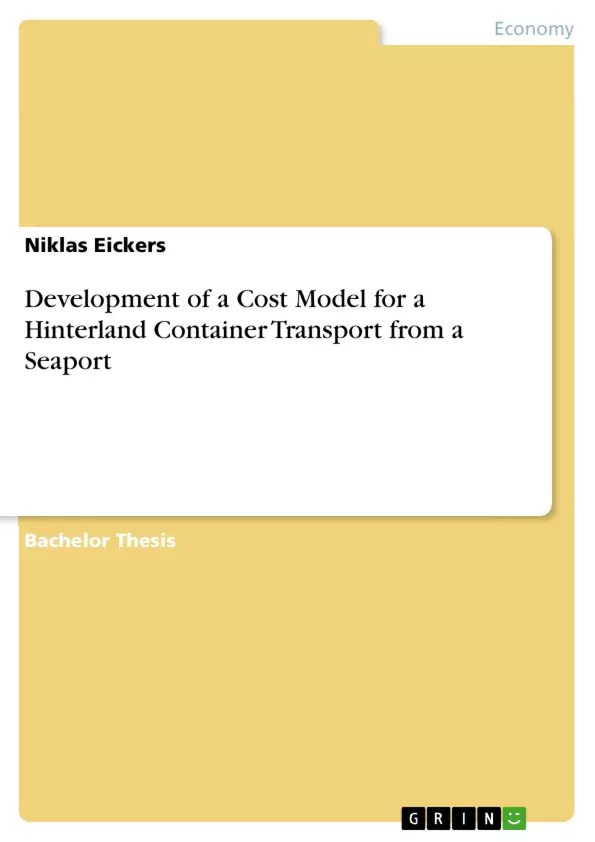In the scope of this thesis, the transport modes of hinterland transportation are analyzed with regard to their benefits and disadvantages. This analysis does not only show their compatibility with hinterland traffic but also their cost factors on the way from a seaport to the hinterland. It is shown which phases a container is passing as well as which expanses are entailed by these operations.
As a first step, a large theoretical basic knowledge shall be created. Therefore, all locations and operators of the supply chain for a hinterland container are introduced, general requirements as well as processes and problems are presented, too.
After presenting the transportation means and their expanses, the developed cost model is applied on an example. The case example shall illustrate single characteristics of each transport mode and shows the proportion of costs.
Finally, the total transport costs for the selected route are determined and the transport modes can be compared again. Moreover, a recommendation for the carrier choice of this example is given. This recommendation is specially focused on the aspects costs and time which represent the most important factors in the logistics sector.
Inhaltsverzeichnis (Table of Contents)
- 1 Introduction
- 1.1 Backgrounds
- 1.2 Objective of the Work
- 1.3 Methodology
- 1.4 Structure of the Thesis
- 2 The Seaport and its Characteristics
- 3 The Transport of a Container from a Seaport to the Hinterland
- 3.1 The Definition and Delimitation of the Hinterland
- 3.2 The Hinterland Traffic in Germany
- 3.3 Challenges in the Hinterland Traffic
- 3.4 Requirements of the Customers
- 3.5 Actors of the Hinterland Transport
- 3.6 ISO Container
- 3.6.1 Typical Used Container
- 3.6.2 Advantages and Effects of the Containerization
- 4 The Transport Modes of Containerized Hinterland Traffic
- 4.1 Containerized Hinterland Transport by Train
- 4.1.1 Block Train
- 4.1.2 Single Wagon Load
- 4.2 Containerized Hinterland Transport by Truck
- 4.3 Containerized Hinterland Transport by Barge
- 4.1 Containerized Hinterland Transport by Train
- 5 Cost Modeling for a Containerized Hinterland Transport
- 5.1 Types of Costs
- 5.2 Overview of Theoretical Transport Costs by Train
- 5.3 Overview of Theoretical Transport Costs by Truck
- 5.4 Overview of Theoretical Transport Costs by Barge
- 6 Determination of Transport Costs for the Route Rotterdam-Duisburg
- 6.1 Transportation Costs by Rail
- 6.1.1 Transshipment Costs Seaport
- 6.1.2 Main Line Operation Costs by Rail
- 6.1.3 Transshipment Costs Hinterland Terminal
- 6.1.4 Total Costs Train
- 6.2 Transportation Costs by Truck
- 6.2.1 Transshipment Costs Seaport
- 6.2.2 Main Line Operation Costs by Truck
- 6.2.3 Total Costs Truck
- 6.3 Transportation Costs by Barge
- 6.3.1 Transshipment Costs Seaport
- 6.3.2 Main Line Operation Costs by Barge
- 6.3.3 Transshipment Costs Hinterland Terminal
- 6.3.4 Total Costs Barge
- 6.4 Analysis and Evaluation of the Case Example
- 6.1 Transportation Costs by Rail
Zielsetzung und Themenschwerpunkte (Objectives and Key Themes)
This thesis aims to develop a cost model for a containerized hinterland transport from a seaport, focusing on the route from Rotterdam to Duisburg. The study explores the different transport modes involved, namely rail, truck, and barge, and analyzes the associated costs. The objective is to provide a comprehensive analysis of the costs associated with each mode and evaluate their suitability for the specific route.
- Containerized Hinterland Transport
- Cost Modeling
- Seaport Operations
- Transport Modes: Rail, Truck, Barge
- Route Analysis: Rotterdam-Duisburg
Zusammenfassung der Kapitel (Chapter Summaries)
The thesis begins by introducing the background, objective, and methodology of the study. Chapter 2 provides a detailed analysis of the characteristics of the seaport, highlighting its role in global trade. Chapter 3 focuses on the transport of containers from the seaport to the hinterland, defining the hinterland, outlining challenges faced in hinterland traffic, and identifying key actors involved. This chapter also explores the importance of ISO containers and their impact on transportation. Chapter 4 delves into the specific transport modes used for containerized hinterland traffic, including train, truck, and barge. It presents an overview of each mode and its characteristics, exploring different variants like block trains and single wagon loads. Chapter 5 focuses on cost modeling, identifying different types of costs and providing an overview of theoretical transport costs for each mode. Finally, chapter 6 presents a detailed analysis of transportation costs for the Rotterdam-Duisburg route, considering each transport mode and its associated costs. The chapter concludes with an analysis and evaluation of the case example, comparing the effectiveness and cost-efficiency of each mode for the chosen route.
Schlüsselwörter (Keywords)
The key focus areas of this thesis include containerized hinterland transport, cost modeling, seaport operations, transport modes (rail, truck, barge), route analysis, Rotterdam-Duisburg route, and cost comparison. The study explores the complexities of moving goods efficiently and cost-effectively from a seaport to inland destinations, highlighting the importance of a comprehensive cost analysis for decision-making.
- Quote paper
- Niklas Eickers (Author), 2016, Development of a Cost Model for a Hinterland Container Transport from a Seaport, Munich, GRIN Verlag, https://www.grin.com/document/452534



